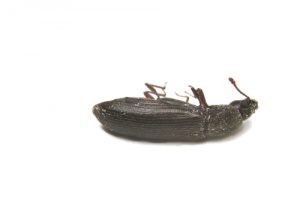“Shot Holes” in Wood
By Chris Williams on October 14, 2011.
Q. Would termites cause lots of tiny, round holes (I call them “shot holes”) in a wooden dresser?
A. No, it’s not termites that have caused that damage for two reasons: (1) Termites in our area are usually found in damp or moisture-damaged wood, and they usually reach that wood from their colonies in the ground, so termites infesting a dresser is not likely. (2) Termites do not leave round holes in wood. They feed in galleries inside wood but they enter and leave that wood either directly through soil or through mud tubes, rather than through holes.
 I’m guessing that the holes you’re seeing are what we call beetle exit holes. [There’s always the chance that the holes are not insect-caused at all, made by a cat’s claws or a 7 year-old boy with a hammer and a nail!] When wood-boring beetles infest wood, the larvae feed on the wood, then complete their development and become adults while still inside the wood. They then bore holes to reach the outside. These exit holes vary in size and shape, depending on the type of wood-boring beetle involved.
I’m guessing that the holes you’re seeing are what we call beetle exit holes. [There’s always the chance that the holes are not insect-caused at all, made by a cat’s claws or a 7 year-old boy with a hammer and a nail!] When wood-boring beetles infest wood, the larvae feed on the wood, then complete their development and become adults while still inside the wood. They then bore holes to reach the outside. These exit holes vary in size and shape, depending on the type of wood-boring beetle involved.
Powderpost beetles are probably the most common wood boring beetle found in homes. They leave tiny, perfectly round exit holes, ranging from 1/32 to 1/4-inch in diameter. There are three different types of powderpost beetles and the size of the holes varies slightly depending on which beetle is doing the damage. You may also find even smaller holes belonging to tiny wasp parasites that attack powderpost beetles in their galleries.
Another wood-boring beetle, called the old house borer, leaves much larger, oval-shaped exit holes in wood. Sometimes, homeowners will find holes that seem excessively elongated. These are not exit holes at all, but are cross-sections of beetle galleries that were already present in the wood when the lumber was cut.
It sounds, though, like you’re seeing powderpost beetle damage in your dresser. The question is whether it’s old damage from an infestation that has since died out, or whether you have new exit holes from an infestation that is still ongoing. One sign that the infestation is active is light-colored, powdery frass (digested wood) that is pushed out of the exit holes and ends up on surfaces below. An expert can tell by the feel of the frass and the size of the holes which powderpost beetle is doing the damage.
Some powderpost beetles infest only hardwoods, some softwoods, and some can infest either. Most powderpost beetles can reinfest wood if moisture levels and other conditions are right, but others rarely reinfest once they emerge from the wood.
You don’t say whether you own this dresser or how long you’ve had it, or what it’s made of, so I can’t be much more specific in my answer. You should have a pest control company inspect the dresser and other nearby wood to determine whether the infestation is active, the extent of the infestation, and what control actions are necessary, if any. Give Colonial a call. Our experts can also tell you if it was a kid with a nail!